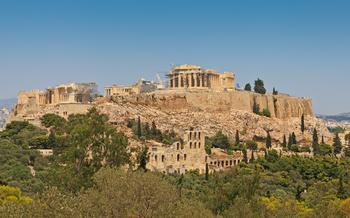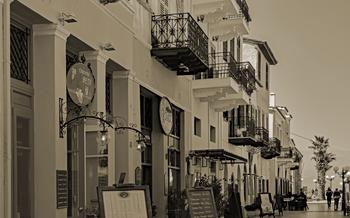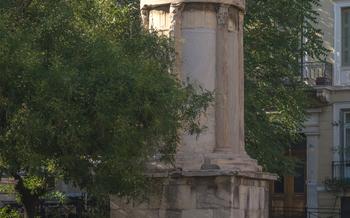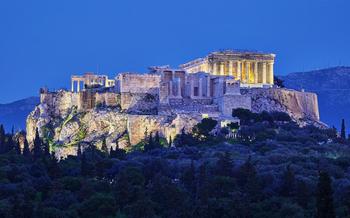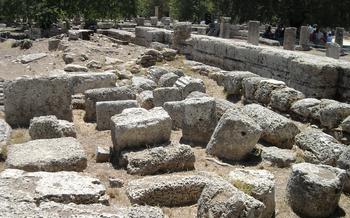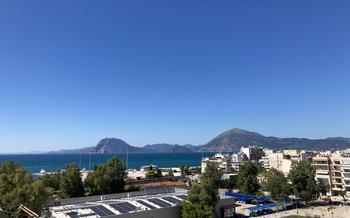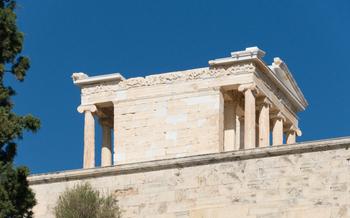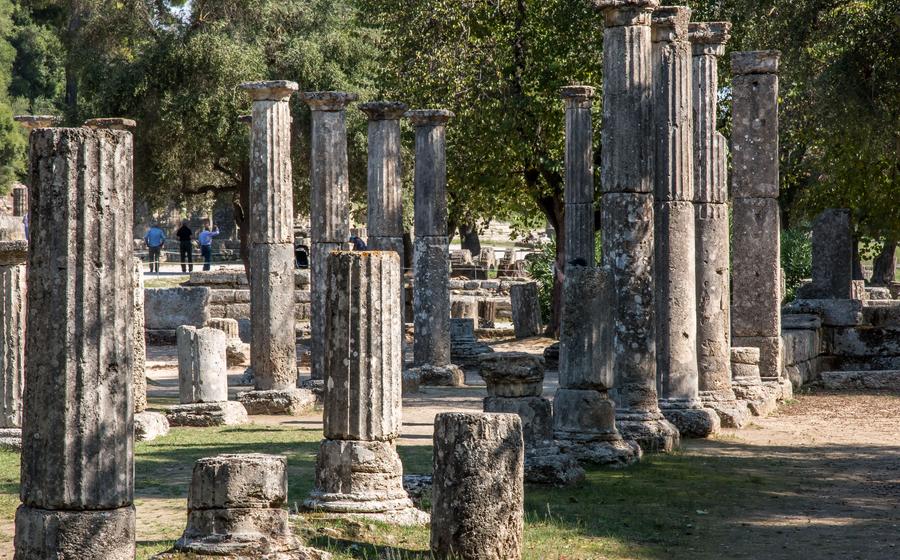
Apollo Epicurius at Bassae
- The Temple of Apollo Epicurius at Bassae: A UNESCO World Heritage Site
- Exploring the Enchanting Ruins of Bassae
- A Glimpse into Ancient Greek Architecture
- The Cult of Apollo and Its Connection to Bassae
- Unraveling the Mysteries of Iktinos, the Temple's Architect
- The Temple's Enduring Legacy and Influence
- Transportation and Accessibility
- Planning Your Visit: Essential Tips
- Admission Fees and Operating Hours
- Exploring the Surrounding Area
- Accommodation Options Near Bassae
- Dining and Refreshments
- Photography and Videography
- Souvenirs and Local Specialties
- Insider Tip: Discover Hidden Gems
The Temple of Apollo Epicurius at Bassae: A UNESCO World Heritage Site
Nestled amidst the picturesque hills of southwestern Greece, the Temple of Apollo Epicurius stands as a testament to the architectural brilliance and religious fervor of ancient Greece. Built in the 5th century BC, the temple is an exceptional example of classical Greek architecture and has earned its place as a UNESCO World Heritage Site. Its unique design, impressive scale, and well-preserved state make it a must-visit destination for history enthusiasts, architecture buffs, and travelers seeking to immerse themselves in the wonders of the ancient world.
The temple's history is closely intertwined with the cult of Apollo, the Olympian god of healing, music, and prophecy. According to mythology, Apollo was revered in Bassae, and the temple was constructed as a sanctuary dedicated to his worship. The exact circumstances surrounding its construction remain shrouded in mystery, but the temple's existence reflects the significance of Apollo's cult in the region.
The Temple of Apollo Epicurius is situated in a remote and secluded valley, surrounded by rolling hills and lush vegetation. Its strategic location, away from the hustle and bustle of urban centers, adds to its allure and creates a sense of tranquility that enhances the visitor's experience. The surrounding landscape, with its rugged beauty and unspoiled nature, provides a stunning backdrop for the temple and complements its architectural grandeur.
Exploring the Enchanting Ruins of Bassae
As you approach the Temple of Apollo Epicurius at Bassae, you'll be greeted by a magnificent sight—a collection of ancient ruins that have withstood the test of time. While the temple has undergone significant deterioration over the centuries, its enchanting remains offer a glimpse into the architectural prowess of ancient Greece.
The most striking feature of the ruins is the array of columns that once supported the temple's roof. These massive columns, some of which are still standing, showcase the skill and precision of the temple's builders. Take a moment to admire their intricate capitals, which feature intricate carvings and designs.
Among the ruins, you'll also find fragments of sculptures and other decorative elements that once adorned the temple. These include pieces of friezes, pediments, and metopes, which offer a glimpse into the temple's original grandeur. Look closely, and you may even be able to discern traces of the vibrant colors that once covered these sculptures.
One unique aspect of the Temple of Apollo Epicurius is its orientation. Unlike most Greek temples, which typically face east, this temple faces west. This unusual orientation is believed to have been chosen to align with the setting sun, creating a dramatic effect during certain times of the year.
A Glimpse into Ancient Greek Architecture
The Temple of Apollo Epicurius at Bassae stands as a testament to the ingenuity and architectural prowess of ancient Greece. Its unique features and design elements make it a valuable case study for understanding the development of Greek architecture.
The temple's most striking feature is its unusual orientation. Unlike most Greek temples, which are aligned east-west, the Temple of Apollo Epicurius faces northeast. This orientation is thought to have been chosen to align the temple with the rising sun on the god's birthday.
Another unique aspect of the temple is its use of the Doric order, which is characterized by its simple and robust columns. However, the temple's architects employed several innovative variations on the traditional Doric style. For example, the columns are slightly tapered, and the capitals have a distinctive "cushion" shape. These modifications demonstrate the architects' willingness to experiment with new ideas and push the boundaries of architectural design.
The temple's construction techniques also provide valuable insights into ancient Greek building practices. The use of large stone blocks, precision cutting, and careful assembly techniques showcases the exceptional craftsmanship of the builders. The temple's remarkable state of preservation, despite its age and exposure to the elements, is a testament to the durability and resilience of ancient Greek architecture.
Studying the Temple of Apollo Epicurius offers a glimpse into the architectural ingenuity of ancient Greece. Its unique orientation, innovative use of the Doric order, and sophisticated construction techniques make it a valuable resource for understanding the development of one of the world's most influential architectural traditions.
The Cult of Apollo and Its Connection to Bassae
In ancient Greek mythology, Apollo was a multifaceted deity associated with various domains, including music, poetry, healing, prophecy, and the sun. He was revered as the son of Zeus, the king of the gods, and Leto, a Titan goddess. Apollo's cult was widespread throughout Greece, and Bassae was one of the significant religious centers dedicated to his worship.
The Temple of Apollo Epicurius served as a sacred site where devotees gathered to honor and seek favor from the god. The temple's location, atop a remote mountain peak, added to its mystique and aura of divine presence. Inscriptions and archaeological evidence suggest that the temple was the focal point of religious rituals and ceremonies.
Among the rituals performed at Bassae, one of the most notable was the offering of sacrifices to Apollo. Devotees would bring animals, such as sheep or goats, to the temple, where they would be ritually slaughtered and offered to the god. These sacrifices were believed to appease Apollo and gain his favor.
In addition to sacrifices, other forms of worship and devotion took place at the temple. Devotees would offer prayers, libations (offerings of wine or oil), and votive offerings (objects dedicated to the god) in hopes of receiving Apollo's blessings and protection. The temple also served as a place of divination, where priests interpreted signs and omens to provide guidance and insight to those seeking answers from Apollo.
The cult of Apollo at Bassae played a vital role in the religious life of the ancient Greeks in the region. The temple was a sanctuary where devotees could connect with the divine and seek Apollo's blessings, guidance, and protection in various aspects of their lives.
Unraveling the Mysteries of Iktinos, the Temple's Architect
The Temple of Apollo Epicurius owes its existence to the genius of Iktinos, a renowned architect who left an indelible mark on the history of ancient Greek architecture. Born in the 5th century BC, Iktinos hailed from the city of Athens and was known for his innovative and groundbreaking designs. His most celebrated work, the Parthenon in Athens, stands as a testament to his architectural prowess and remains one of the most iconic structures of the ancient world.
Iktinos's design for the Temple of Apollo Epicurius showcases his mastery of proportion and harmony. The temple's unique orientation, rotated slightly off the traditional east-west axis, is believed to have been intentional, aligning the structure with the path of the sun during the summer solstice. This alignment suggests that the temple may have served as an astronomical observatory, a testament to Iktinos's scientific and mathematical knowledge.
Beyond the Temple of Apollo Epicurius, Iktinos is credited with designing several other notable structures, including the Telesterion of Eleusis, a vast hall used for the Eleusinian Mysteries, and the Temple of Athena Nike on the Athenian Acropolis. His work is characterized by its elegance, simplicity, and attention to detail, showcasing his deep understanding of the principles of classical Greek architecture.
Iktinos's legacy extends far beyond his own lifetime. His contributions to architecture served as a foundation for subsequent Greek and Roman architects, influencing the development of Western architecture for centuries to come. Modern architects continue to draw inspiration from his work, finding in it timeless principles of design and aesthetics that remain relevant to this day.
The Temple's Enduring Legacy and Influence
The Temple of Apollo Epicurius has left an indelible mark on the world of architecture, serving as a testament to the enduring power of ancient Greek design. Its unique features and innovative construction techniques have influenced generations of architects, both in antiquity and beyond.
The temple's influence can be seen in the subsequent development of Greek architecture, particularly in the Doric style. Its use of the Corinthian order, with its distinctive capitals adorned with acanthus leaves, became a hallmark of later Greek temples. The temple's emphasis on symmetry, balance, and proportion set a standard for classical architecture that would be emulated for centuries.
Beyond Greece, the Temple of Apollo Epicurius has influenced Roman and later Western architecture. Its design principles and aesthetic elements were adopted by Roman architects, who incorporated them into their own temples and public buildings. The temple's influence can also be seen in Renaissance and Baroque architecture, where classical forms and motifs were revived and reinterpreted.
In modern times, the temple has served as a source of inspiration for architects and artists. Its unique design and picturesque setting have captured the imagination of creatives worldwide, leading to its depiction in paintings, sculptures, and even films. The temple's enduring legacy continues to inspire and captivate, demonstrating its timeless appeal and profound impact on the history of architecture.
Transportation and Accessibility
Reaching the Temple of Apollo Epicurius at Bassae is a journey that takes you through the heart of the Peloponnese region in Greece. While the temple's remote location adds to its allure, it also requires careful planning for your visit.
Getting to Bassae:
-
From Athens: Embark on a scenic 3-hour drive through the picturesque countryside, following the Peloponnese Motorway and enjoying the changing landscapes.
-
From Kalamata: Take a leisurely 5-hour drive along the scenic coastal road, passing through charming villages and olive groves.
-
Public Transportation: While there are limited public transportation options directly to Bassae, you can take a bus from Athens or Kalamata to the nearby town of Andritsaina and then hire a taxi or arrange for a guided tour to the temple.
-
Guided Tours: To delve deeper into the history and significance of the temple, consider booking a guided tour from Athens or Kalamata. These tours typically include transportation, entrance fees, and expert commentary.
Driving Directions:
-
If driving from Athens or Kalamata, follow the signs to Andritsaina and then to the village of Bassae. The road leading to the temple is well-maintained and accessible by regular vehicles.
-
Parking: Ample parking space is available near the temple, allowing you to conveniently leave your car and embark on your exploration of this ancient wonder.
Planning Your Visit: Essential Tips
Planning your visit to the Temple of Apollo Epicurius at Bassae requires careful consideration to ensure a rewarding and enjoyable experience. Here are some essential tips to help you make the most of your trip:
Timing Your Visit: Choose the right time to visit Bassae to avoid extreme weather conditions and crowds. The best time to visit is during the shoulder seasons (April-May and September-October) when the weather is pleasant, and the site is less crowded.
Duration of Your Visit: Allocate sufficient time to explore the site and its surroundings adequately. Plan to spend at least two to three hours at the temple to appreciate its architectural wonders and soak in the serene atmosphere.
Packing Essentials: Pack comfortable footwear suitable for walking on uneven terrain, as you will be exploring the ruins and the surrounding area. Additionally, bring a hat, sunscreen, and water, especially if visiting during the summer months.
Admission Fees and Operating Hours
Admission to the Temple of Apollo Epicurius is subject to a modest entrance fee, which contributes to the preservation and maintenance of the site. The operating hours vary depending on the season and may be affected by weather conditions. During the summer months, the temple is typically open from early morning until late afternoon, while during the winter months, the hours may be shorter.
Guided tours are available for visitors who wish to delve deeper into the history and significance of the temple. These tours are led by knowledgeable guides who can provide insights and answer questions about the site. Guided tours are offered at specific times throughout the day, and it is advisable to inquire about their availability and make reservations in advance.
Exploring the Surrounding Area
Beyond the awe-inspiring Temple of Apollo Epicurius, the region of Bassae offers a wealth of additional attractions to enrich your visit. Immerse yourself in the captivating history and natural beauty that surrounds this ancient site.
Ancient Messene: Just a short drive from Bassae, discover the remarkably preserved ruins of Ancient Messene, a city founded in the 4th century BC. Explore its well-preserved theater, agora, and defensive walls, offering a glimpse into the grandeur of ancient Greek city planning.
Nestor's Palace: Located near the village of Pylos, approximately an hour's drive from Bassae, lies the legendary Palace of Nestor. Unearthed by archaeologists, this Bronze Age palace is believed to have been the residence of King Nestor, a prominent figure in Homer's Iliad. Marvel at the palace's impressive architecture and artifacts, providing a tangible connection to ancient Greek mythology.
Voidokoilia Beach: Escape the historical sites and unwind at the idyllic Voidokoilia Beach, situated about an hour's drive from Bassae. This picturesque horseshoe-shaped beach boasts crystal-clear waters, soft golden sand, and stunning views of the surrounding landscape. Enjoy a refreshing swim, soak up the Mediterranean sun, or simply relax on the beach and admire the breathtaking scenery.
Mount Ithome and Cave of Zeus: For nature enthusiasts and hikers, Mount Ithome beckons with its verdant slopes and challenging trails. Ascend to the summit to be rewarded with panoramic views of the surrounding countryside. Along the way, visit the Cave of Zeus, a sacred site in ancient Greek mythology believed to be the birthplace of the almighty god Zeus. Explore its mystical chambers and learn about the legends associated with this revered location.
Accommodation Options Near Bassae
While planning your visit to the Temple of Apollo Epicurius at Bassae, consider staying in the vicinity to fully immerse yourself in the region's history and natural beauty. Although accommodation options directly at the temple are limited, several charming hotels and guesthouses are located in nearby towns and villages.
For a comfortable and convenient stay, opt for hotels in the town of Andritsaina, situated just 15 kilometers from Bassae. These hotels offer a range of amenities, including comfortable rooms, traditional Greek cuisine, and stunning views of the surrounding mountains.
For a more budget-friendly option, consider guesthouses or traditional Greek lodgings in the picturesque village of Stemnitsa, approximately 30 kilometers from the temple. These guesthouses provide a cozy and authentic experience, allowing you to connect with the local culture and savor delicious homemade dishes.
When booking your accommodation, reserve your stay well in advance, especially during the peak tourist season from May to September. Check for availability and compare rates online to find the best deals. Alternatively, consider contacting local travel agencies or tourist information centers for personalized recommendations and assistance.
For those seeking a unique and immersive experience, consider staying in a traditional stone-built house in one of the surrounding villages. These charming accommodations offer a glimpse into the region's rich history and provide an authentic taste of rural Greek life.
Dining and Refreshments
Due to its remote location, dining options at Bassae are limited. There are no restaurants or cafes in the immediate vicinity of the temple. However, visitors can bring their own food and drinks and enjoy a picnic in the designated areas.
For a truly memorable experience, pack a delicious spread of local delicacies. Choose from fresh fruits, olives, cheese, bread, and pastries from the nearby villages. Don't forget to include a bottle of Greek wine to complement your meal.
As you savor your picnic, take in the breathtaking views of the surrounding landscape. The temple ruins, set against the backdrop of the rolling hills and lush greenery, create a picturesque setting for a delightful outdoor repast.
Photography and Videography
Capturing the essence of the Temple of Apollo Epicurius through photography and videography is an enriching experience. The ruins, with their weathered columns and intricate carvings, present a picturesque subject for photographers. While capturing the beauty of the temple, it's essential to adhere to certain guidelines.
-
Respectful Photography: Be mindful of other visitors and avoid obstructing their views or causing disturbances while taking photos.
-
Permissions: Generally, photography and videography for personal use are permitted at the temple. However, if you intend to use your images or footage for commercial purposes, it's advisable to seek permission from the relevant authorities.
-
Composition Tips: Experiment with different angles and perspectives to create captivating shots. Use the surrounding landscape, such as the rolling hills or vibrant wildflowers, to add depth and context to your images.
-
Natural Light: The best time for photography is during the golden hours of sunrise or sunset when the warm light casts a magical glow on the ruins.
-
Capture Details: Focus on the intricate details of the temple, such as the finely carved capitals, fluted columns, and decorative friezes. These elements add depth and character to your photographs.
-
Share Your Work: Once you've captured your shots, consider sharing them with the world. Tag your photos on social media using relevant hashtags or join online photography communities to connect with fellow enthusiasts.
Souvenirs and Local Specialties
While exploring Bassae, you'll have the opportunity to take home a piece of history and culture through souvenirs and local specialties. The region offers a variety of unique items that showcase the region's rich traditions and craftsmanship.
Handcrafted Ceramics: Explore the local shops to find beautiful handmade ceramics, including pottery, plates, and vases. These intricate pieces are often decorated with traditional Greek motifs and vibrant colors, making them a perfect memento of your visit.
Traditional Woven Textiles: Discover the art of traditional weaving in the surrounding villages. Skilled artisans create exquisite textiles, such as rugs, blankets, and tablecloths, using time-honored techniques. These colorful creations are not only visually stunning but also highly durable and practical.
Local Honey and Olive Oil: Indulge in the flavors of the Peloponnese by purchasing local honey and olive oil. The region is renowned for its high-quality honey, produced by bees that feed on the nectar of wild thyme and other aromatic flowers. The olive oil, made from locally grown olives, is known for its rich taste and health benefits.
Authentic Greek Products: Support the local community by purchasing authentic Greek products, such as herbs, spices, and traditional sweets. These items are often sold in small shops or at local markets. You can find everything from aromatic oregano and thyme to delicious baklava and loukoumades, a popular Greek dessert.
Insider Tip: Discover Hidden Gems
Venture beyond the Temple of Apollo Epicurius and explore the charming village of Andritsaina, nestled amidst the picturesque Arcadian countryside. Immerse yourself in the authentic Greek way of life as you stroll through the cobblestone streets, admiring the traditional architecture and vibrant local culture.
Andritsaina is renowned for its delectable cuisine, offering a culinary journey that will tantalize your taste buds. Indulge in mouthwatering dishes prepared with fresh, local ingredients, showcasing the rich flavors of the region. From hearty stews and succulent grilled meats to homemade pastries and sweet delights, Andritsaina's culinary scene is a treasure trove waiting to be explored.
Complement your gastronomic adventure with a visit to the Museum of Andritsaina, a cultural gem that unveils the fascinating history and traditions of this captivating village. Immerse yourself in captivating exhibits that showcase ancient artifacts, traditional costumes, and historical documents, providing a glimpse into the rich tapestry of Andritsaina's past.
Whether you seek culinary delights or historical insights, Andritsaina offers a unique and enriching experience that will leave you with lasting memories of your journey through Greece.


